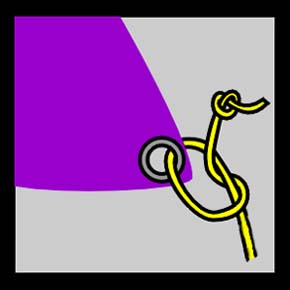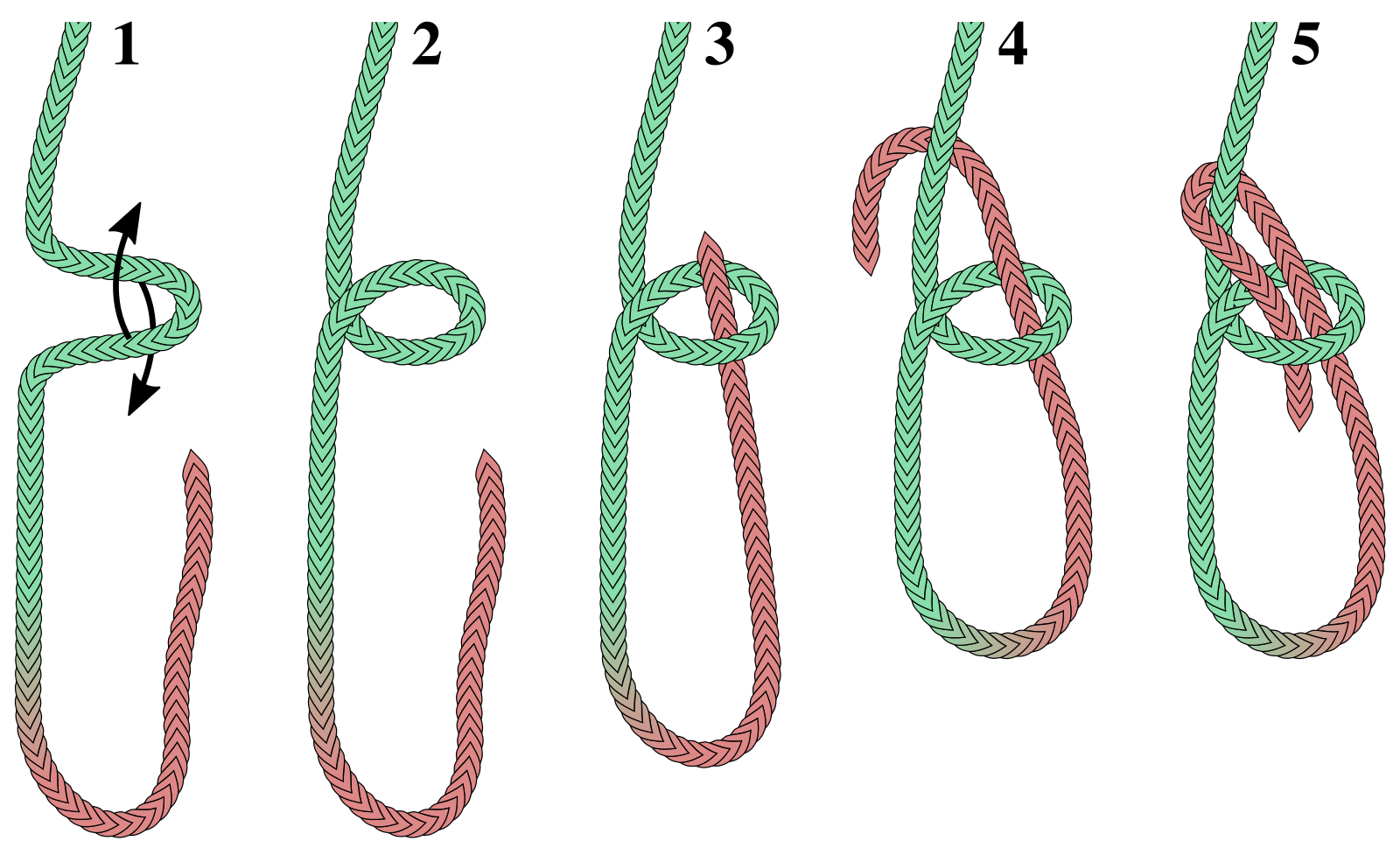|
Barrel Hitch
The "barrel hitch" and " barrel sling", named for their use in hoisting cargo aboard ships, are two simple yet effective ways to suspend an object. The barrel sling lays the barrel on its side, while the barrel hitch keeps it vertical. They work by forming a "sling" around the object, which supports it from either side and underneath. The barrel sling (not pictured) is made with a strop. The barrel is laid on its side, both sides of the strop are spread out and passed underneath, the ends of the strop are raised together, one end is tucked through the other and hooked to an eyehook. The tightened knot looks like a cow hitch. A cow hitch and bowline can achieve the same effect and are called a "cow hitch hoist". The barrel hitch for lifting bales of hay is called a "bale sling hitch". Tying *The barrel hitch is made by tying an overhand knot, leaving plenty of free rope at the working end. Where the rope crosses itself in the middle of the knot (near the target), grab the ... [...More Info...] [...Related Items...] OR: [Wikipedia] [Google] [Baidu] |
Overhand Knot
The overhand knot is one of the most fundamental knots, and it forms the basis of many others, including the simple noose, overhand loop, angler's loop, reef knot, fisherman's knot, Half hitch, and water knot. The overhand knot is a stopper, especially when used alone, and hence it is very secure, to the point of jamming badly. It should be used if the knot is intended to be permanent. It is often used to prevent the end of a rope from unraveling. An overhand knot becomes a trefoil knot, a true knot in the mathematical sense, by joining the ends. It can also be adjusted, faired, or mis-tied as a half hitch Tying There are a number of ways to tie the Overhand knot. * Thumb method – create a loop and push the working end through the loop with your thumb. * Overhand method – create a bight, by twisting the hand over at the wrist and sticking your hand in the hole, pinch the working end with your fingers and pull through the loop. Heraldry In heraldry, the overhand knot ... [...More Info...] [...Related Items...] OR: [Wikipedia] [Google] [Baidu] |
Bowline
The bowline ( or ) is an ancient and simple knot used to form a fixed loop at the end of a rope. It has the virtues of being both easy to tie and untie; most notably, it is easy to untie after being subjected to a load. The bowline is sometimes referred to as ''King of the knots'' because of its importance. Along with the sheet bend and the clove hitch, the bowline is often considered one of the most essential knots. The common bowline shares some structural similarity with the sheet bend. Virtually all end-to-end joining knots (i.e., bends) have a corresponding loop knot. Although the bowline is generally considered a reliable knot, its main deficiencies are a tendency to work loose when not under load (or under cyclic loading), to slip when pulled sideways, and the bight portion of the knot to capsize in certain circumstances. To address these shortcomings, a number of more secure variations of the bowline have been developed for use in safety-critical applications, or by s ... [...More Info...] [...Related Items...] OR: [Wikipedia] [Google] [Baidu] |
Bale Sling Hitch
{{knot-stub ...
The bale sling hitch (or strap hitch) is a knot which traditionally uses a continuous loop of strap to form a cow hitch around an object in order to hoist or lower it. In practice, a similar arrangement can also be formed using a fixed loop at the end of a rope. This loop could be formed at the end of a line with a knot, such as the bowline, or a large eye splice. See also *List of knots *List of hitch knots References loop knot This page explains commonly used terms related to knots. B Bend A bend is a knot used to join two lengths of rope. Bight A bight has two meanings in knotting. It can mean either any central part of a rope (between the standing end an ... [...More Info...] [...Related Items...] OR: [Wikipedia] [Google] [Baidu] |
Cow Hitch
The cow hitch, also called the lark's head, is a hitch knot used to attach a rope to an object. The cow hitch comprises a pair of half-hitches tied in opposing directions, as compared to the clove hitch in which the half-hitches are tied in the same direction. It has several variations and is known under a variety of names. It can be tied either with the end of the rope or with a bight. History A simple and useful knotted structure, the cow hitch has been known since at least the first century when described by Greek physician Heraklas in a monograph on surgical knots and slings. Known under a variety of names, this knot has been used both on land and at sea. The common alternate name "lark's head" is attributed to Tom Bowling (pseudonym) in the 1866 work ''The Book of Knots'' which is presumed to have been adapted from a French manuscript; lark's head is a literal translation of the French name for the knot, ''tête d'alouette''.Ahsley, p. 11. Variations The underlying ... [...More Info...] [...Related Items...] OR: [Wikipedia] [Google] [Baidu] |
Barrel Hitch Instructions
A barrel or cask is a hollow cylindrical container with a bulging center, longer than it is wide. They are traditionally made of wooden staves and bound by wooden or metal hoops. The word vat is often used for large containers for liquids, usually alcoholic beverages; a small barrel or cask is known as a keg. Modern wooden barrels for wine-making are made of French common oak (''Quercus robur''), white oak (''Quercus petraea''), American white oak (''Quercus alba''), more exotic is Mizunara Oak all typically have standard sizes: Recently Oregon Oak (Quercus Garryana) has been used. *"Bordeaux type" , *"Burgundy type" and *"Cognac type" . Modern barrels and casks can also be made of aluminum, stainless steel, and different types of plastic, such as HDPE. Someone who makes barrels is called a "barrel maker" or cooper (coopers also make buckets, vats, tubs, butter churns, hogsheads, firkins, kegs, kilderkins, tierces, rundlets, puncheons, pipes, tuns, butts, pins, tr ... [...More Info...] [...Related Items...] OR: [Wikipedia] [Google] [Baidu] |
Overhand Knot
The overhand knot is one of the most fundamental knots, and it forms the basis of many others, including the simple noose, overhand loop, angler's loop, reef knot, fisherman's knot, Half hitch, and water knot. The overhand knot is a stopper, especially when used alone, and hence it is very secure, to the point of jamming badly. It should be used if the knot is intended to be permanent. It is often used to prevent the end of a rope from unraveling. An overhand knot becomes a trefoil knot, a true knot in the mathematical sense, by joining the ends. It can also be adjusted, faired, or mis-tied as a half hitch Tying There are a number of ways to tie the Overhand knot. * Thumb method – create a loop and push the working end through the loop with your thumb. * Overhand method – create a bight, by twisting the hand over at the wrist and sticking your hand in the hole, pinch the working end with your fingers and pull through the loop. Heraldry In heraldry, the overhand knot ... [...More Info...] [...Related Items...] OR: [Wikipedia] [Google] [Baidu] |


